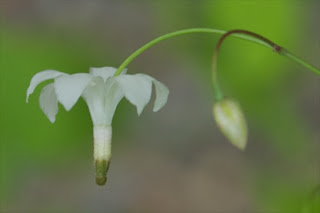 |
Vancouveria hexandra is found at low to mid elevations in our local forests and is a tough and adaptable perennial. Often evergreen in mild winter conditions, it is deciduous when grown in colder weather . It is also quite cold hardy and is reported to thrive in gardens in Pennsylvania and Vermont, far from its Pacific NW native habitat.
Vancouveria hexandra spreads slowly by underground rhizomes to form a charming groundcover to 18” tall. Grow in part to full shade in humus rich, moist to dry soil. Because of its drought tolerance, it is a welcome addition to our dry shade garden.
Available now at the nursery. We also expect to offer it in our 2012 online mail order catalog.






Love this charmer - an eye catcher in the woodland garden. Yes, at first one thinks Epimedium, so I'm not surprised to hear it is 'related'. Now that I know it's other common name, how could any self-respecting Oregon Duck's fan be without this! Skip
ReplyDeleteIt was first described as an Epimedium after being collected in 1792 during the expedition led by George Vancouver. When botanist Hooker moved it into its own genus in 1829, he named it after the great explorer. You are right that duck foot is a very appropriate common name, both for a native plant of the rainy Northwest and especially for UO fans.
ReplyDeleteIf I live in a fairly maritime location (800 feet away from the Burrard Inlet and ~170 feet above sea level) and I were to use this plant in a part shade location...how "evergreen" will it be? I've heard it will look ratty and yellowish in the late cold winter, can anyone give me a second opinion?
ReplyDeleteIn milder climates, it will not be completely deciduous and the old foliage can look tired by late winter. You can cut back last year's foliage as you would for Epimediums just as the new growth tips emerge at soil level. I use garden shears to make the job quick and easy, being careful not to cut off the new growth.
ReplyDelete